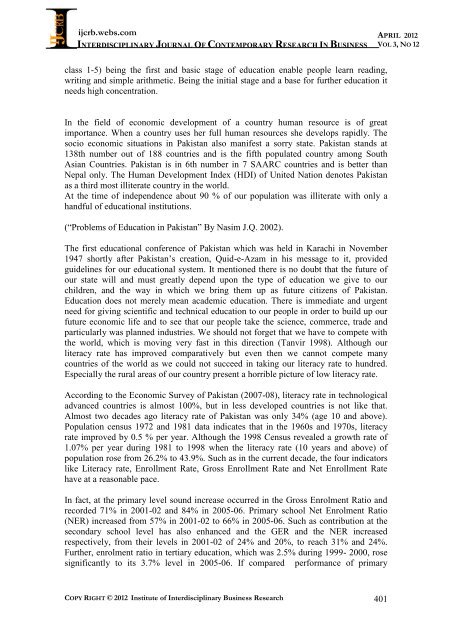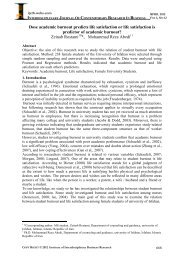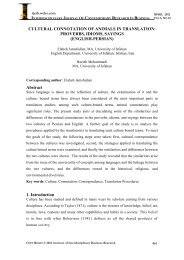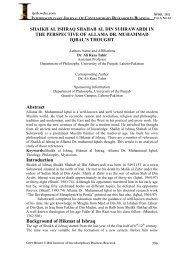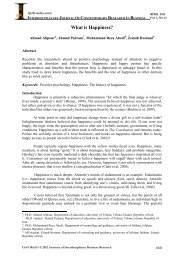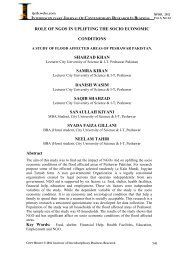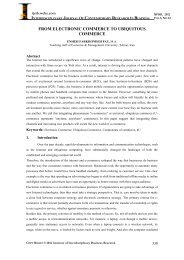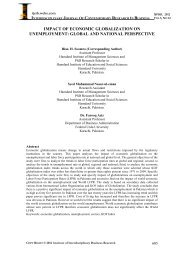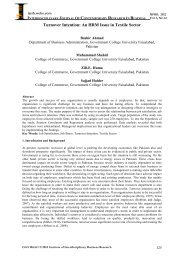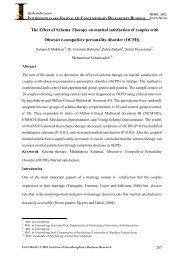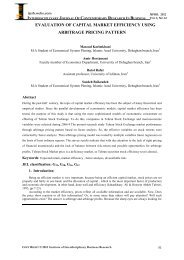a comparative study of the facilities in rural and urban - journal ...
a comparative study of the facilities in rural and urban - journal ...
a comparative study of the facilities in rural and urban - journal ...
You also want an ePaper? Increase the reach of your titles
YUMPU automatically turns print PDFs into web optimized ePapers that Google loves.
ijcrb.webs.com<br />
INTERDISCIPLINARY JOURNAL OF CONTEMPORARY RESEARCH IN BUSINESS<br />
APRIL 2012<br />
VOL 3, NO 12<br />
class 1-5) be<strong>in</strong>g <strong>the</strong> first <strong>and</strong> basic stage <strong>of</strong> education enable people learn read<strong>in</strong>g,<br />
writ<strong>in</strong>g <strong>and</strong> simple arithmetic. Be<strong>in</strong>g <strong>the</strong> <strong>in</strong>itial stage <strong>and</strong> a base for fur<strong>the</strong>r education it<br />
needs high concentration.<br />
In <strong>the</strong> field <strong>of</strong> economic development <strong>of</strong> a country human resource is <strong>of</strong> great<br />
importance. When a country uses her full human resources she develops rapidly. The<br />
socio economic situations <strong>in</strong> Pakistan also manifest a sorry state. Pakistan st<strong>and</strong>s at<br />
138th number out <strong>of</strong> 188 countries <strong>and</strong> is <strong>the</strong> fifth populated country among South<br />
Asian Countries. Pakistan is <strong>in</strong> 6th number <strong>in</strong> 7 SAARC countries <strong>and</strong> is better than<br />
Nepal only. The Human Development Index (HDI) <strong>of</strong> United Nation denotes Pakistan<br />
as a third most illiterate country <strong>in</strong> <strong>the</strong> world.<br />
At <strong>the</strong> time <strong>of</strong> <strong>in</strong>dependence about 90 % <strong>of</strong> our population was illiterate with only a<br />
h<strong>and</strong>ful <strong>of</strong> educational <strong>in</strong>stitutions.<br />
(“Problems <strong>of</strong> Education <strong>in</strong> Pakistan” By Nasim J.Q. 2002).<br />
The first educational conference <strong>of</strong> Pakistan which was held <strong>in</strong> Karachi <strong>in</strong> November<br />
1947 shortly after Pakistan’s creation, Quid-e-Azam <strong>in</strong> his message to it, provided<br />
guidel<strong>in</strong>es for our educational system. It mentioned <strong>the</strong>re is no doubt that <strong>the</strong> future <strong>of</strong><br />
our state will <strong>and</strong> must greatly depend upon <strong>the</strong> type <strong>of</strong> education we give to our<br />
children, <strong>and</strong> <strong>the</strong> way <strong>in</strong> which we br<strong>in</strong>g <strong>the</strong>m up as future citizens <strong>of</strong> Pakistan.<br />
Education does not merely mean academic education. There is immediate <strong>and</strong> urgent<br />
need for giv<strong>in</strong>g scientific <strong>and</strong> technical education to our people <strong>in</strong> order to build up our<br />
future economic life <strong>and</strong> to see that our people take <strong>the</strong> science, commerce, trade <strong>and</strong><br />
particularly was planned <strong>in</strong>dustries. We should not forget that we have to compete with<br />
<strong>the</strong> world, which is mov<strong>in</strong>g very fast <strong>in</strong> this direction (Tanvir 1998). Although our<br />
literacy rate has improved <strong>comparative</strong>ly but even <strong>the</strong>n we cannot compete many<br />
countries <strong>of</strong> <strong>the</strong> world as we could not succeed <strong>in</strong> tak<strong>in</strong>g our literacy rate to hundred.<br />
Especially <strong>the</strong> <strong>rural</strong> areas <strong>of</strong> our country present a horrible picture <strong>of</strong> low literacy rate.<br />
Accord<strong>in</strong>g to <strong>the</strong> Economic Survey <strong>of</strong> Pakistan (2007-08), literacy rate <strong>in</strong> technological<br />
advanced countries is almost 100%, but <strong>in</strong> less developed countries is not like that.<br />
Almost two decades ago literacy rate <strong>of</strong> Pakistan was only 34% (age 10 <strong>and</strong> above).<br />
Population census 1972 <strong>and</strong> 1981 data <strong>in</strong>dicates that <strong>in</strong> <strong>the</strong> 1960s <strong>and</strong> 1970s, literacy<br />
rate improved by 0.5 % per year. Although <strong>the</strong> 1998 Census revealed a growth rate <strong>of</strong><br />
1.07% per year dur<strong>in</strong>g 1981 to 1998 when <strong>the</strong> literacy rate (10 years <strong>and</strong> above) <strong>of</strong><br />
population rose from 26.2% to 43.9%. Such as <strong>in</strong> <strong>the</strong> current decade, <strong>the</strong> four <strong>in</strong>dicators<br />
like Literacy rate, Enrollment Rate, Gross Enrollment Rate <strong>and</strong> Net Enrollment Rate<br />
have at a reasonable pace.<br />
In fact, at <strong>the</strong> primary level sound <strong>in</strong>crease occurred <strong>in</strong> <strong>the</strong> Gross Enrolment Ratio <strong>and</strong><br />
recorded 71% <strong>in</strong> 2001-02 <strong>and</strong> 84% <strong>in</strong> 2005-06. Primary school Net Enrolment Ratio<br />
(NER) <strong>in</strong>creased from 57% <strong>in</strong> 2001-02 to 66% <strong>in</strong> 2005-06. Such as contribution at <strong>the</strong><br />
secondary school level has also enhanced <strong>and</strong> <strong>the</strong> GER <strong>and</strong> <strong>the</strong> NER <strong>in</strong>creased<br />
respectively, from <strong>the</strong>ir levels <strong>in</strong> 2001-02 <strong>of</strong> 24% <strong>and</strong> 20%, to reach 31% <strong>and</strong> 24%.<br />
Fur<strong>the</strong>r, enrolment ratio <strong>in</strong> tertiary education, which was 2.5% dur<strong>in</strong>g 1999- 2000, rose<br />
significantly to its 3.7% level <strong>in</strong> 2005-06. If compared performance <strong>of</strong> primary<br />
COPY RIGHT © 2012 Institute <strong>of</strong> Interdiscipl<strong>in</strong>ary Bus<strong>in</strong>ess Research 401


